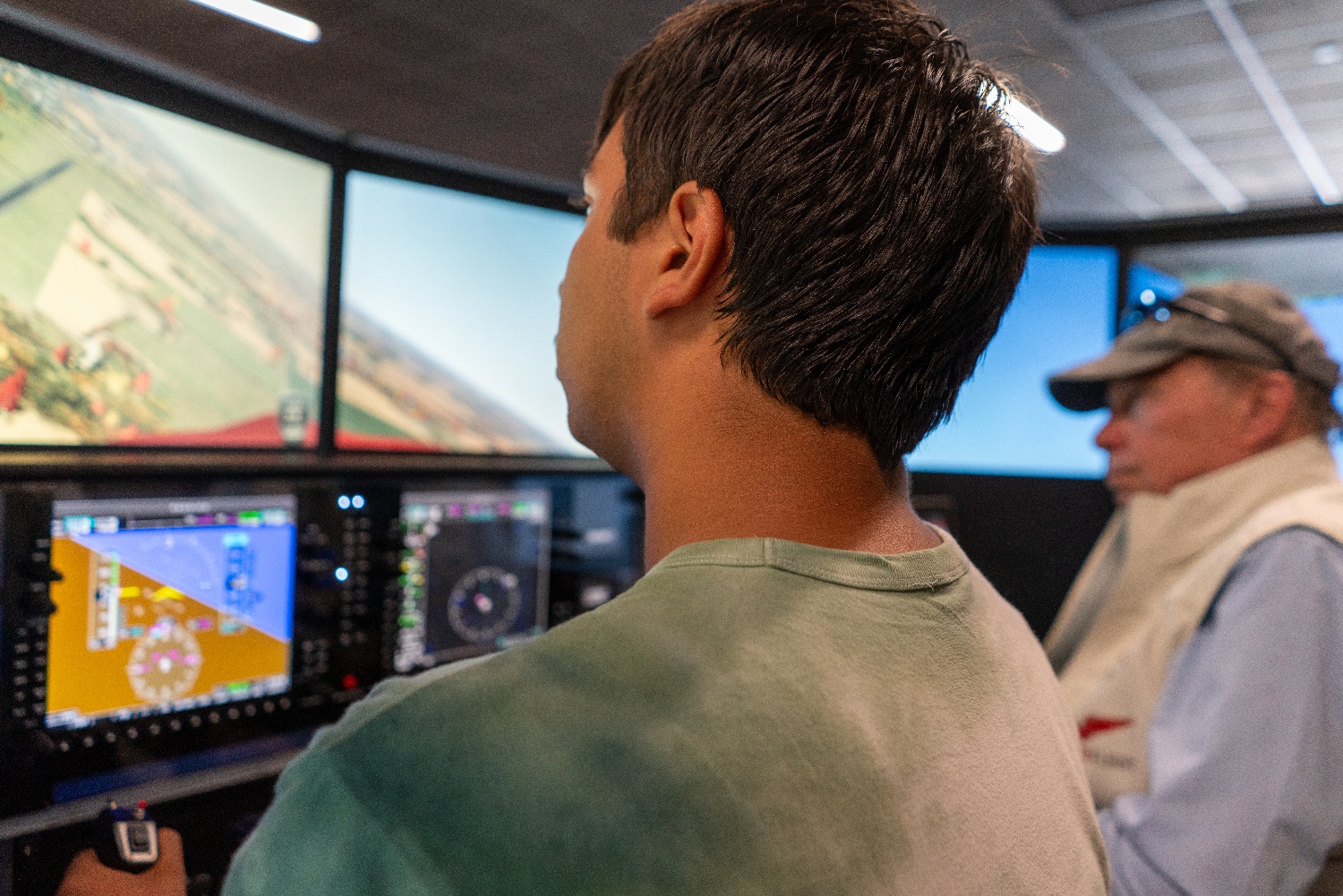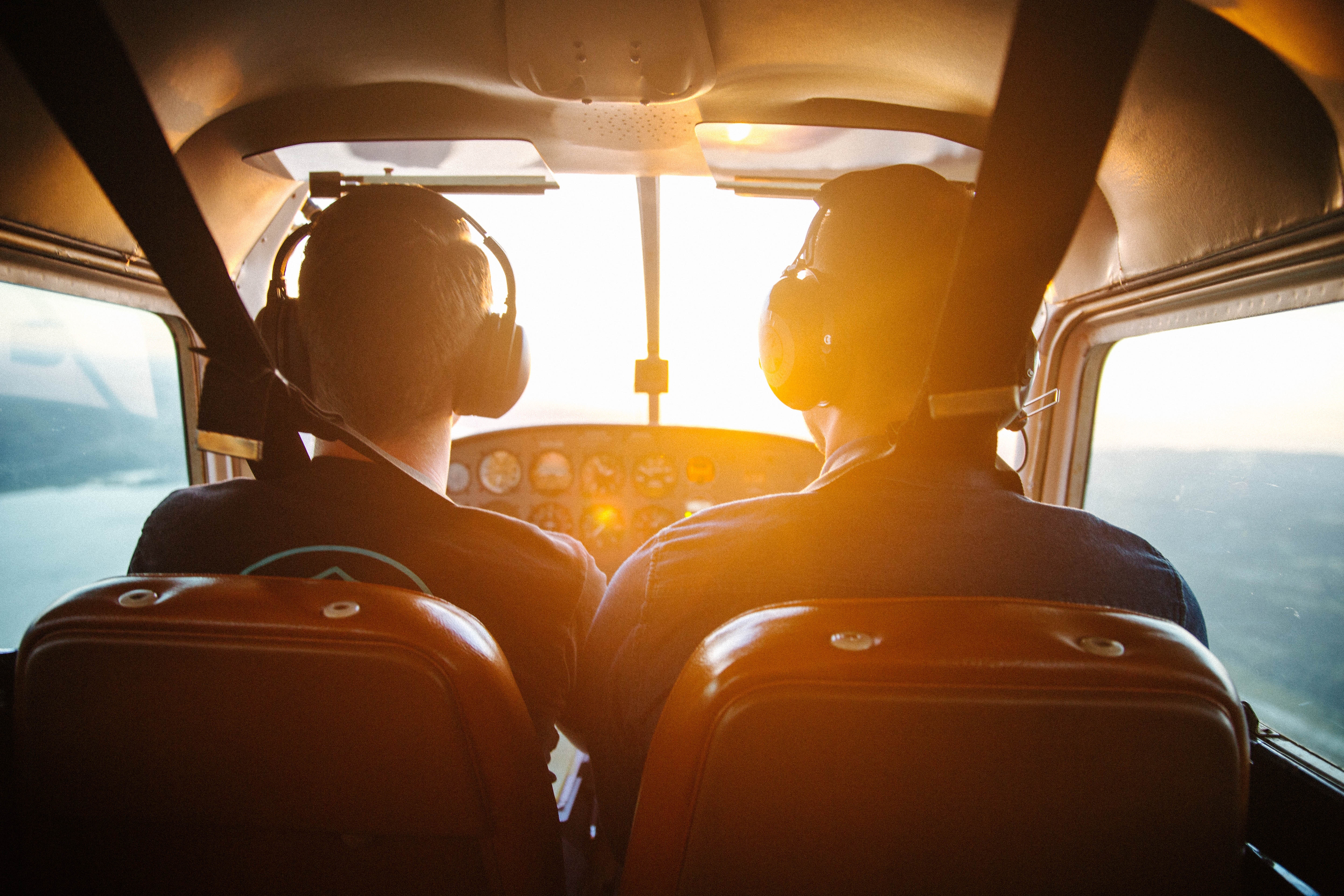How Pilot Training in a Flight Simulator Increases Flight School Revenue
Flight schools can improve student pilot success and maximize profitability by using flight simulators to a greater extent than is typical. Students in primary pilot training can benefit from an introduction to new maneuvers and practice that builds muscle memory. Instrument students can master procedures. Commercial, CFI/I MEI, ATP, and rotor wing students can perform an expansive list of tasks in a sim.
Integrating flight simulation into an existing operation is simple, and the benefits are undeniable. The key is providing the structure and organization to do so. Fortunately, it’s not hard, nor particularly time-consuming.
However, many flight training providers miss out on the maximum operational efficiency of sim training, often because misconceptions prevent them from purchasing a simulator or integrating it effectively into a curriculum.
Misconceptions About Flight Simulator Training
A few primary misconceptions stand in the way of training providers maximizing the earning potential of a flight simulator.
1. Students only want to fly the airplane during training.
Of course, student pilots want to fly in the airplane, but they would prefer to do it as a certificated pilot, filing their own flight plan with loved ones on board rather than a flight instructor. In other words, they want to get through primary flight training as efficiently as possible.
Furthermore, each day that passes increases the likelihood that a prospective pilot walking through the doors of a flight school grew up with the internet, social media, and a growing list of technological innovations. These aspiring aviators have put in thousands of hours on Microsoft Flight Simulator. Intuitively, they understand how flight simulation will help them accomplish their real-world goal — which, again, is to get their certificate, not to burn avgas at the flight school.
2. Time-building flight instructors won’t use the flight simulator.
Admittedly, flight instructor adoption and usage of the simulator is a tougher nut to crack. The State of Flight Training Report we produce each year paints a clear picture of the discrepancy between how pilots and prospective pilots perceive flight simulator training and how certified flight instructors (CFIs) perceive it.
However, the deeper issue highlighted in the report is how flight training organizations view simulator training.
If a school has a positive outlook on simulator training and implements it effectively into its operations, the flight instructors on staff could accrue more time in the real cockpit building hours with students in the left seat.
Furthermore, with hours in the sim under their belt, those students will have a better feel for maneuvers, freeing up CFIs to handle the more interesting work of fine-tuning skills and evaluating aeronautical decision-making in the airplane rather than trudging through hours of rote practice.
With students valuing sim time and flight instructors benefitting from that, the onus is on the school to keep the device up-to-date, integrate it into the curriculum, and show its instructors how to use it effectively. Happy students lead to returning students and more new students, which creates more opportunities for CFIs to build time. However, if management treats the sim like a paperweight, so will its employees.
3. The flight simulator is a stand-in for an airplane.
One of the worst ways to communicate the value of a flight simulator is to limit its use to bad weather days or when training aircraft are down for maintenance. Sure, the sim can keep a flight lesson on the books in a pinch, but using it exclusively as a fallback option sets the stage for a disappointed customer and CFI and, resultantly, a subpar training session.
When a flight school purchases and takes delivery of a flight simulator, it should do its due diligence to understand the areas where a sim excels and how management can leverage them. Among others, a flight simulator has the distinct advantages of being more efficient and cost-effective to operate than an airplane and facilitating a superior learning experience with less noise, workload, and stress.
At Redbird, we like to say the simulator is the classroom, and the airplane is the showroom. The worldwide database in a flight simulator lets you go where the training is best, and you can focus on the lesson at hand, like shooting another approach, rather than wasting time circling back around the practice area.
The simulator is a workhorse—cheaper, easier, and less intimidating than the airplane, and therefore, better suited for introducing and practicing skills before students demonstrate them in the air.
4. Reducing aircraft time per student pilot will reduce revenue potential.
Flight schools generally graduate 20% of the students who begin primary flight training. The business results would be significant if a school achieved only a modest increase by graduating 30% of students. Here’s an example.
Windy Wings Flight School has 100 students begin primary flight training each year. 20 of those students end up with a private pilot certificate. Given the following numbers, here’s what that means in revenue.
- 20 students fly 75 hours each in Windy Wings rental airplanes at, say, $140/hour for a total of $210,000.00.
- 80 students fly 20 hours each (then drop out) for a total of $224,000.00.
- Total = $434,000.00 annually from rental fees.
The next year, Windy Wings uses flight simulators more in primary training, particularly early in the curriculum, leading to graduating 30 students out of 100 each year.
- The 30 graduating students only need 55 hours in rental planes to graduate but also spend 20 hours in a flight sim at $70/hour. They save time and money.
- The 70 non-graduating students spend 20 hours in rental planes and 10 in a sim.
- Total = $518,000.00 annually, an increase of $84,000.00.
Not bad! Remember, this example represents only a modest improvement in graduation rate. Other changes (all positive) will occur, not the least of which is more students will choose a flight school with a better graduation rate and first-time pass rate over others through word-of-mouth recommendations. Further, potential clients may decide to begin flight training with that school because of its effectiveness instead of forgoing their pursuit of a pilot certificate altogether.
Increasing Student Retention With Flight Simulator Training

You may be wondering why increased simulator inclusion would yield such results. It all boils down to student recruitment, retention, and the residual effects of getting more satisfied students through the finish line.
Most people looking into flight training believe it is expensive, dangerous, difficult, time-consuming, inconvenient, dependent on weather and airplane maintenance, and the quality of instruction can be hit-and-miss. To be fair, some of those are correct.
Upon researching your flight school, however, the perception could be that it is comparatively affordable, safe, high-quality, and predictable, making a certificate seem more achievable.
When used to its fullest potential, a simulator will increase client satisfaction.
- It is perceived as less scary and provides a much better learning environment than the cockpit of an actual airplane.
- It saves students money by learning and practicing at a cheaper hourly rate. Reduced cost versus your competition is often enough to close the deal.
- Happier students will increase the buzz about your operation through word-of-mouth, attracting new business.
Start Right at the Discovery Flight
A discovery flight is a magical moment in a new student’s journey—except when it’s not. While many students find the cockpit exciting and motivating, others feel overwhelmed and reluctant to continue. For that reason, every discovery flight should also include some simulator time.
One method of successful flight schools is to put the prospective student in a simulator to learn straight and level flight and avionics basics. Then, the student and instructor move on to the airplane and return to the simulator upon landing. There, the student can relive and rehearse things they did in the airplane, such as making turns and moving the throttle.
Integrate the Flight Simulator Into Your Operations
While functionally, you should utilize your aircraft and flight simulators differently, operationally, you should treat them both as valued tools in your fleet.
- Integrate your simulators into your curriculum. Learning to fly can be improved if teaching methods and your syllabus properly leverage a sim. Popular curricula such as those from Sporty’s and King Schools already have Redbird training programs like Guided Independent Flight Training (GIFT) integrated into their TCOs. We are happy to assist you with your integration as well.
- Assign each simulator as a rental asset in your scheduling system alongside your fleet of aircraft. Platforms like Flight Schedule Pro make this easy to accomplish.
- Implement a simulator checkride and currency requirement for your CFIs.
How To Teach in a Flight Simulator
Introduce maneuvers and procedures in the simulator — for example, steps to start the engine or perform normal turns.
- Repetition is the key, and it’s easy in a sim.
- Break each task into smaller subtasks.
- Repeat each subtask until it’s second nature.
Repeat in the airplane to mastery, which won’t take long. Then, check off on a training roadmap to show progress and move on to the next lesson.
Here’s an example using a lesson on takeoffs in a Redbird simulator. Students should learn each element to mastery before moving to the next element.
- Learn to stay on the centerline while taxiing.
- Learn to stay on the centerline while accelerating down the runway to takeoff speed.
- Learn to scan the airspeed indicator during the takeoff roll.
- Learn when and how to rotate and transition into a Vy climb.
- Learn crosswind correction.
- Learn power failure procedure.
Again, the speed with which a student can practice a maneuver, then instantly return to their starting point and try again, is a massively beneficial feature of simulators that creates more efficient and higher quality learning.
Once these skills have been mastered and assembled into a smooth procedure, the student and CFI can move on to ADM elements such as selecting a runway based on wind, go/no go decisions, and more general pilot-in-command (PIC) decision-making.
Self-Guided Training in a Flight Simulator
Redbird simulators allow students to fly anywhere, anytime, under any conditions. Hop into the simulator, input your desired location and position, and go.
Say you want a student to practice pattern work at your airport. Simply put the plane where you want it with any weather and time of day, and save that flight in the Redbird Navigator menu.
Going beyond saved flights, students may also use purpose-built software called GIFT, which teaches how to perform all the maneuvers necessary to pass a checkride, including pre-solo maneuvers, ground reference maneuvers, takeoffs, landings, engine-out scenarios, cross-country flights, and more. We also offer a version for instrument training.
The benefit of GIFT is that it enables students to practice alone, limiting time with CFIs to more critical aspects of training, like evaluating decision-making. If a flight school utilizes GIFT effectively to book an otherwise vacant sim without the overhead of an hourly instructor rate, the revenue bump can become substantial over time.
Every GIFT lesson includes an instructional video, written material, and simulator session supported by an AI-powered CFI that offers instantaneous verbal feedback and, crucially, corrective instructions and action during a maneuver to keep the training focused and productive.
After the simulator session, the student receives a score based on the Airman Certification Standards (ACS), subdivided into specific elements. Perhaps the student’s roll angle was spot on during their turn, but they strayed too much from their altitude. Not only would they receive instant verbal feedback during the steep turn, but their score would show that they did a great job holding a 45° bank, but they descended more than 100 feet during the maneuver. This data is stored in the cloud for the student, instructor, and school to review anytime.
The Bottom Line
Any flight school can leverage a flight simulator to increase its graduation rate and customer satisfaction. It simply has to decide to do it. Contact us for more information and free tools that will help you create a plan to integrate a training device into your program successfully.
Share this
You May Also Like
These Related Articles
-2.jpeg)
How Top Flight Schools Use Full Motion Flight Simulators

How Dedicated Technical Support Keeps Your Flight Simulator Running Smoothly

.png?width=1274&height=716&name=Instructors%20vs%20Students%20-%20Simulator%20Edition%20(1).png)